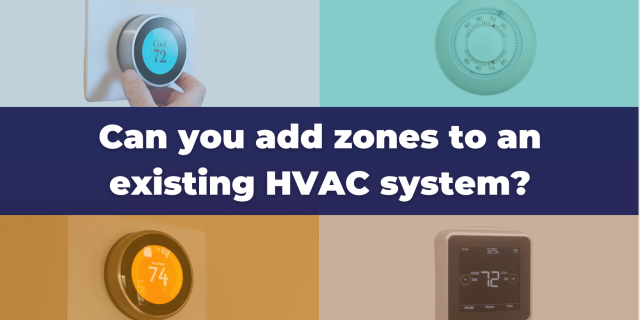What to Do When One Room is Hot and One Room is Cold

If you’ve ever wondered what to do when one room is hot and another is cold, you’re not alone. Many homeowners face the challenge of maintaining a consistent temperature throughout their homes. Uneven heating or cooling can lead to discomfort, frustration, and higher energy bills. Fortunately, HVAC zoning offers a solution by directing heating or cooling precisely where it’s needed. In this blog post, we’ll explore how HVAC zoning works and how it can improve your home’s comfort and efficiency.
Understanding the Problem: Uneven Room Temperatures
Uneven room temperatures can be a frustrating and persistent problem in many households. Traditional HVAC systems rely on a single thermostat to control the entire home’s climate, which doesn’t account for the unique characteristics of each room. Several factors contribute to this issue, including room size, the number and orientation of windows, insulation quality, and even household activities like cooking or using electronics that generate heat. For instance, rooms with large windows facing the sun may become excessively hot, while shaded or poorly insulated rooms may stay cooler. Our Answerbook explains more about uneven temperatures.
Having one room that’s too hot while another room is too cold can make it challenging to find a comfortable temperature setting that works for the entire house. This leads to frequent thermostat adjustments and increased energy consumption. The constant battle to achieve uniform comfort can be both inconvenient and costly. However, there is a solution. HVAC zoning can provide targeted temperature control, making every room in your home comfortable.
How HVAC Zoning Solves Temperature Imbalances
HVAC zoning tackles temperature imbalances by dividing your home into distinct zones, each managed by its own thermostat. This approach allows for precise temperature regulation in different areas, meaning you can set your bedroom to a cooler temperature while keeping your living room warmer. Dampers installed in the ductwork control the airflow to each zone based on the thermostat settings, ensuring that only the necessary amount of heating or cooling is delivered to each area.
This targeted control eliminates the problem of one room being too hot while another is too cold. By providing the right amount of heating or cooling exactly where and when it is needed, HVAC zoning improves comfort throughout your home. Additionally, it optimizes energy use by preventing over-conditioning in areas that don’t require it. This can lead to lower energy bills, and who doesn’t love that?
On a hot summer day, you can cool only the rooms you use most often, like the living room and kitchen, while reducing airflow to seldom-used spaces such as guest rooms. During a cold winter night, you might keep your bedrooms warmer while reducing heating in the living room. The flexibility of HVAC zoning accommodates varying comfort preferences and usage patterns, making your home more adaptable and energy-efficient.
The Components of an HVAC Zoning System
An HVAC zoning system is made up of a few essential components: thermostats, control panels, and dampers. Thermostats are installed in each zone, allowing for individual temperature control in different areas of your home. These thermostats communicate with the control panel, which acts as the system’s command center. The control panel interprets the signals from the thermostats and directs the dampers accordingly.
Dampers are installed within the ductwork to regulate the airflow to each zone. When a specific area needs more heating or cooling, the damper for that zone opens to allow air to flow through. The dampers for other zones close to conserve energy. This setup ensures that each zone gets the precise amount of heated or cooled air required. It will immediately fix the issue where one room is too hot and another room is too cold.
In addition to these main components, modern zoning systems may also include advanced features like remote access via smartphone apps, which allow you to adjust settings even when you’re not home. Some systems can integrate with home automation systems, providing even greater control and convenience. These features contribute to the overall efficiency and comfort of your home, making HVAC zoning a smart investment for managing uneven temperatures.
Benefits of HVAC Zoning for Homeowners
HVAC zoning offers homeowners a range of significant advantages. By allowing different areas of the house to be heated or cooled independently, zoning systems provide enhanced comfort tailored to individual preferences. For example, you can set a cooler temperature in the kitchen while keeping bedrooms warmer, creating an optimal environment for each activity and time of day. You will no longer have to say that it’s too hot or too cold in any room!
Energy efficiency is another major benefit. Traditional HVAC systems often waste energy by heating or cooling the entire home uniformly, regardless of room usage. With zoning, you can direct conditioned air only to the spaces that need it, reducing overall energy consumption and lowering utility bills. This targeted approach helps to prevent over-conditioning in seldom-used rooms, ensuring efficient use of your HVAC system.
Another advantage is the reduced wear and tear on your HVAC equipment. Since zoning systems only work as needed for each zone, they experience less strain compared to conventional systems that run continuously to achieve uniform temperature throughout the home. This reduced workload can extend the lifespan of your HVAC system, potentially saving on costly repairs or early replacements.
Modern zoning systems often come with advanced features like remote access and integration with home automation, offering greater convenience and control. These capabilities allow you to manage your home’s climate settings from your smartphone, enhancing overall ease of use and comfort.
Getting Started: Finding an HVAC Contractor
Finding a qualified HVAC contractor is a crucial step in setting up an effective zoning system. Begin by researching professionals with specific experience in installing and servicing HVAC zoning systems. You can gather recommendations from friends or family who have had similar work done, or consult online reviews to gauge customer satisfaction. When reviewing potential contractors, check their credentials, certifications, and any professional affiliations to ensure they meet industry standards.
Our contractor locator is a great place to start.
What to Expect During Installation
When installing an HVAC zoning system, the contractor will first evaluate your current HVAC setup and ductwork to determine the optimal zoning configuration. They will then install dampers inside the ducts to control airflow to different zones. Next, the control panel will be set up to manage these dampers based on signals from the thermostats. These thermostats will be installed in each designated zone throughout your home. Arzel Zoning installation typically takes one day. You’ll be relaxing in your new comfort by evening.
Maintaining Your HVAC Zoning System
Arzel Zoning systems require no maintenance. However, regular upkeep is crucial for ensuring that your HVAC system operates efficiently over time. We recommend routinely changing your air filters, as clean filters enhance airflow and system performance. Schedule annual check-ups with a qualified HVAC technician to inspect the entire system.
By staying proactive with these maintenance tasks, you can enjoy the full benefits of your HVAC zoning system, including consistent comfort, improved energy efficiency, and extended equipment lifespan. Regular attention to your system helps ensure it remains a valuable investment in your home’s comfort and efficiency.
Why Should I Choose Arzel Zoning?
A few things make Arzel Zoning systems unique. Other zoning manufacturers make motorized dampers, but ours are powered by a small air pump located in the control panel. This makes our dampers virtually silent, and it also makes them last longer.
We’re able to offer the best warranty in the industry because our products are so dependable. Just register your system within 90 days of installation, and you’re fully covered.
We also offer a 100% Comfort Guarantee. If you’re not comfortable in the first year of your system’s life, we’ll buy it back from you. We stand behind our zoning systems because we know how effective they are. We use them in our own offices.
Another unique benefit of Arzel Zoning systems is their invisibility. Other solutions, like ductless mini-splits, add equipment to your inside and outside walls. Arzel Zoning is completely hidden inside your ductwork. The only thing you’ll see is a thermostat in each zone, and these can be any type of thermostat you like.
Take a look at our Answerbook to learn more about zoning and how it could work in your home.






